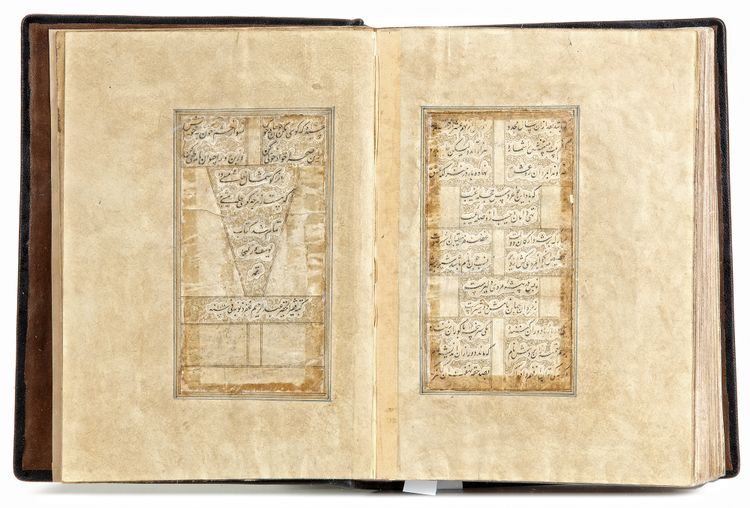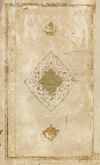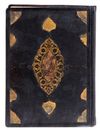YUSUF AND ZULAIKHA BY ABD AL-RAHIM ANBARIN-QALAM, JAMI MAWLANA NUR AD-DIN ABD Al-RAHMAN DATED 1018 AH/1609 AD
Persian manuscripts on paper of 178 leaves with 12 lines to each page, written in black nastaliq script in two columns within gold and blue borders.
The first two pages of nastaliq script in two columns in clouds reserved against with flowers decorated ground, within multiple borders of different colors. With 7 miniatures paintings of Yusuf and Zulaikha in different scenes, pen and ink heightened with gold and opaque pigments on paper. It is signed: ‘Completed at the hand of the sinful Abd-al-Rahim, May almighty Allah conceal his faults and forgive his sins with the dating of 1018 AH/1609 AD’.
24.5 by 18.5 cm.
Persian poems about Yusuf and Zulaikha, mentions that Yusuf was the closest of his sons to Jacob. Yusuf half-brothers were jealous of him, most of them plotted to kill him with the exception of Reuben who suggested to have Yusuf thrown into an empty cistern (miniature 3), intending to rescue Yusuf himself.
Unaware of this secondary intention, the others obeyed his first. Upon imprisoning Yusuf, the brothers saw a camel caravan carrying spices and perfumes to Egypt, and sold Yusuf to these merchants. Ultimately, Yusuf was sold to Potiphar, Aziz of Egypt (miniature 4). Later, Yusuf became Potiphar’s personal servant, and subsequently his household’s superintendent. Zulaikha, the wife of Potiphar, started watching him and following him everywhere as Yusuf grow to be a good soldier and hunter thanks to Aziz of Egypt teaching him (miniature 2, Zulaikha watching Yusuf in a camp during hunting).
Zulaikha tried to seduce Yusuf, which he refused. During his escape his shirt was cut off (miniature 6). The news of this incident spread among the women of the city, Zulaikha wanted to show them the beauty of Yusuf, invited them to a banquet and intentionally gave each woman a knife to cut fruit and ordered Yusuf to enter the hall( miniature 7). When they looked at Yusuf, they were shocked with his beauty and cut their hands without feeling the pain.
The writer:
This book is of Nur ad-Din ‘Abd ar-Rahman Jami, (817 – 898 AH/1414 – 1492 AD) also known as Mawlana Nur al-Din ‘Abd al-Rahman or Abd-Al-Rahman Nur-Al-Din Muhammad Dashti, or simply as Jami or Djami and in Turkey as Molla Cami (7 November 1414 – 9 November 1492), was a Persian Sunni poet who is known for his achievements as a prolific scholar and writer of mystical Sufi literature. He was primarily a prominent poet-theologian of the school of Ibn Arabi and a Khwajagani Sufi recognized for his eloquence and for his analysis of the metaphysics of mercy. His most famous poetic works are Haft Awrang, Tuhfat al-Ahrar, Layla wa -Majnun, Fatihat al-Shabab, Lawa’ih, Al-Durrah al-Fakhirah. Jami belonged to the Naqshbandi Sufi order. A few years after his birth, his family migrated to Herat, where he was able to study Peripateticism, mathematics, Persian literature, natural sciences, Arabic language, logic, rhetoric and Islamic philosophy at the Nizamiyyah University. His father, also a Sufi, became his first teacher and mentor. While in Herat, Jami held an important position at the Timurid court, involved in the era’s politics, economics, philosophy and religious life. His poetry has been inspired by the ghazals of Hafiz, and his famous and beautiful divan Haft Awrang (Seven Thrones) is, by his own admission, influenced by the works of Nizami. The Haft Awrang also known as the long masnavis or mathnawis are a collection of seven poems. Each poem discusses a different story such as the Salaman va Absal that tells the story of a carnal attraction of a prince for his wet-nurse. Throughout Jami’s work references to Sufism and the Sufi emerge as being key topics. Yusuf and Zulaikha is one part of his Haft Awrang (Seven Thrones). The story tells the romance of Yusuf and Zulaikha, wife of Potiphar based on the Islamic traditions, where Zulaikha’s longing for Yusuf represents the soul’s quest for Allah.
The calligrapher:
Abd Al-Rahim Al-Heravi, he was a native of Herat but, as a young man, went to India and entered the service of Abd-al-Raim kan kana son of Bayrem Khan. According to the Maaer-e Raimi, he gained a wide
reputation for his nasta’liq hand, a highly attractive cursive script descended from Persian traditions of calligraphy, while writing manuscripts for Mirza Abd-al-Raim kan kana (1556-1627). After some years kan kana presented him at the court of Akbar because of his proficiency in nasta’liq style, where Abd-al-Raim received an appointment. In recognition of his achievements as calligrapher he received two titles ‘Raushan Qalam and Anbarin Qalam’.
He copied some of the worlds finest poetry for the emperor in swift, measured and elegant script. He became later one of the favourite calligraphers of Sultan Jahangir (1569–1627), who ruled between 1605 and 1627.










